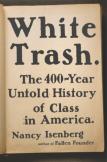'White Trash' blends literature, politics and pop culture of the past 4 centuries to tell the story of class in America.
Reporting on the Donald Trump phenomena back in May, John Harris wrote in the British newspaper The Guardian that while Trump was indeed frightening, his liberal critics relied on “caricatures of rednecks and white trash.” Meanwhile, writing for the conservative National Review, Kevin B. Williamson railed that the “white American underclass is in thrall to a vicious, selfish culture whose main products are misery and used heroin needles. Donald Trump’s speeches make them feel good. So does OxyContin.”
Never mind that numerous analyses have found that Trump’s appeal actually cuts across socioeconomic (if not racial) lines. Either way, if Trump’s candidacy is a problem, pundits on the right and left have thought of it specifically as a “white trash” problem.
Trump’s presidential run is not mentioned in Nancy Isenberg’s comprehensive and fascinating new study. But she does show that for several centuries now, the white underclass has perplexed elites and other observers.
What Isenberg refers to as white trash—not to mention rednecks and crackers, along with more antiquated terms like clay-eaters—have proven to be easily manipulated, yet also transgressive. They have, at times, reinforced the dominant power structure but at other times challenged it. The political ramifications have been (as Trump might say) “huge.”
Isenberg’s aim is to explore the “pervasiveness of a class hierarchy in the United States.”
Contrary to popular myth, Isenberg—a Louisiana State University history professor and the author of Fallen Founder: The Life of Aaron Burr and Sex and Citizenship in Antebellum America—contends that England’s colonial cheerleaders “imagined America not as an Eden of opportunity but as a giant rubbish heap that could be transformed into productive terrain.”
Isenberg wisely structures her early chapters around lesser-known yet illuminating figures like Richard Hakluyt (1530-91), who, along with his son of the same name, were “England’s two chief promoters of American exploration.” Other insightful sources include the travel writer William Byrd II (Virginia, 1720s) and the early “ornithologist and poet” Alexander Wilson (early 1800s).
Particularly revealing is Isenberg’s analysis of the famed radical Thomas Paine, who wanted Americans to “break with the Crown” yet also “not to disturb the class order.” Hence, according to Isenberg, “vast numbers of convict laborers, servants, apprentices, working poor and families living in miserable wilderness cabins are all absent from [Paine’s] prose.” Sadly (presumably because of a paucity of sources), we don’t hear much directly from these people in Isenberg’s book either.
Still, from John Locke and Ben Franklin to Andy Griffith and Sarah Palin, the breadth of Isenberg’s material is impressive. If Lin-Manuel Miranda (of the Broadway show “Hamilton”) can find hip-hop in America’s early days, then why not Isenberg? She compares Davy Crockett and others to “certain masters of gangsta rap [who] had to make up for their lowly status by dressing themselves up in a boisterous verbal garb.”
One of Isenberg’s key figures is Andrew Jackson, whose “rough edges” made it easy to forget he was a “slaveholding planter whose reputation situated him not in the halls of power but among the common stock.”
In short, for better or worse, powerful political figures could forge a connection to the powerless. By 1840, Isenberg writes, the once-lowly “squatter” had “morphed into the colloquial common man of democratic lore.” But America’s race and class warfare came to bloody fruition when “Confederate ideology converted the Civil War into a class war.”
In the book’s second half, Isenberg ably guides the reader through the diverse class ramifications of the eugenics movement, the Great Depression, restrictive housing covenants and the presidencies of the Southerners Lyndon B. Johnson, Jimmy Carter and Bill Clinton. The book starts to feel more like a freewheeling magazine piece, with riffs blending literature, politics and pop culture. Isenberg’s kitchen-sink analysis is impressive, though its coverage of so much territory invariably draws attention to what she has left out. (Why analyze “Deliverance” and “The Beverly Hillbillies” but not, say, rural depictions in “Twilight Zone” episodes, or the notorious torture scene in “Pulp Fiction,” which is oozing with Southern-fried sleaze? Or even Eminem’s rap, “White Trash Party”?)
On the political end, Isenberg could have used a more forthright analysis of why, since the 1960s, poor whites have moved so rapidly and loyally rightward, even though they “were the beneficiaries of rehabilitative efforts during the New Deal and in L.B.J.’s Great Society.”
There is another potential problem, albeit unintended, with Isenberg’s book. In recent years, there has been an explosion of online interest—often from white nationalist groups—in slavery as it was experienced by whites in America. Isenberg herself emphasizes the terrible conditions of such “coerced labor,” noting that as far back as the early 17th century, “leaders of Jamestown had borrowed directly from the Roman model of slavery.”
Bigots have selectively explored this history and asked: If these people could “get over” slavery, why can’t African-Americans? Isenberg, of course, is suggesting nothing of the sort. But in the eternal American conflict over race and class, emphasizing one often means failing to acknowledge the importance of the other.
Ultimately, though, Eisenberg’s is a necessary and important book. It is hard to refute her when she forcefully argues: “We must stop declaring...that Americans...escaped the burden of class that prevailed in the mother country of England.”
This article also appeared in print, under the headline “Underclass Rebellion,” in the October 24, 2016, issue.








